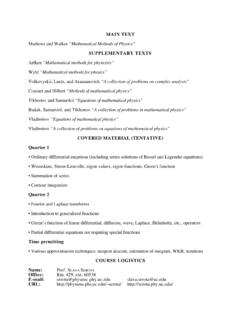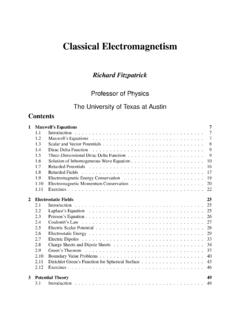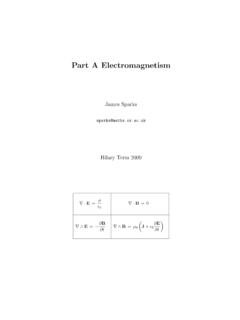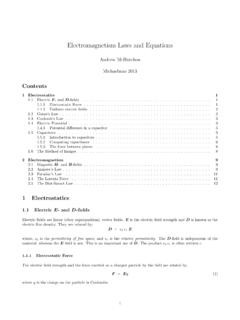Transcription of INTRODUCTION The Electromagnetic Spectrum
1 I 1I. What is Electromagnetic radiation and theelectromagnetic Spectrum ?What do light, X-rays, heat radiation, microwaves, radio waves, and gamma radiationhave in common? Despite their differences, they are all the same kind of stuff. They alltravel through space and have similar electrical and magnetic effects on matter. This stuff is called Electromagnetic radiation, because it travels (radiates) and has electrical andmagnetic radiation is the means for many of our interactions with the world: lightallows us to see; radio waves give us TV and radio; microwaves are used in radar commu-nications; X-rays allow glimpses of our internal organs; and gamma rays let us eavesdropon exploding stars thousands of light-years away. Electromagnetic radiation is the messen-ger, or the signal from sender to receiver. The sender could be a TV station, a star, or theburner on a stove. The receiver could be a TV set, an eye, or an X-ray film. In each case, thesender gives off or reflects some kind of Electromagnetic these different kinds of Electromagnetic radiation actually differ only in a singleproperty their wavelength.
2 When Electromagnetic radiation is spread out according to itswavelength, the result is a Spectrum , as seen in Fig. 1. The visible Spectrum , as seen in arainbow, is only a small part of the whole Electromagnetic Spectrum . The electromagneticspectrum is divided into five major types of radiation. As shown in Fig. 1, these includeradio waves (including microwaves), light (including ultraviolet, visible, and infrared), heatradiation, X-rays, gamma rays, and cosmic rays. Your eye can detect only part of the lightINTRODUCTIONThe Electromagnetic SpectrumFig. Electromagnetic Eye Response {increasingincreasingdecreasingdecreasin gdecreasingincreasingENERGY frequencywavelengthCosmic and gamma raysX-raysUltravioletLghtVisibleLightRad io WavesHeatRadiationInfraredLighti 2spectrum. Humans cannot sense any other part of the Electromagnetic Spectrum without theaid of special equipment. Other animals (such as bees) can see the ultraviolet while some(snakes) can see the infrared.}
3 In each case, the eye (or other sense organ) translates radia-tion (light) into information that we (or the bee looking for pollen or the snake looking forprey) can 1 s human eye response is a magnified portion of the Electromagnetic spectrumand represents the sensitivity of the average human eye to Electromagnetic radiation. As thisgraph shows, the human eye is most sensitive to light in the middle part of the visiblespectrum: green and yellow. This is why emergency vehicles are often painted garish yellowsor green they stand out in all weather, including fog, and at night better than the old-fashioned fire-truck red. The eye is much less sensitive toward the red and purple ends ofvisible light. The infrared and ultraviolet portions of the Spectrum are invisible to the beginning of the modern age, mankind has expanded its ability to see into otherparts of the Electromagnetic Spectrum . X-rays have proved useful for looking inside otherwiseopaque objects such as the human body.
4 Radio waves have allowed people to communicateover great distances through both voice and pictures. Today, increasingly clever uses of thespectrum allow us to see into the heart of a molecule (or person) while exploring Earth andspace for the benefit of Light and colorAs shown in Fig. 1, each type of Electromagnetic radiation has its own wavelength. Butwhat length of what wave? Electromagnetic radiation moves through space (not just outerspace, but the atmosphere, buildings, lenses, etc.) as a wave, as wavelike changes in elec-trical and magnetic properties, similar to waves on the surface of water. The wavelength ofelectromagnetic radiation is the distance from the peak of a wave to the next peak, as shownin Fig. waves can also be described by their frequency that is, how manytimes a wave waves in a unit of time. For instance, imagine yourself as a ticket taker at asports arena. Say 65 people pass your booth in 10 minutes. So, people pass you perminute the frequency of people passing is people per minute.
5 The frequency of anelectromagnetic wave is exactly the same thing: the number of whole waves (or cycles) thatpass by a point in some amount of time. Television and radio waves are usually describedby their frequency; your favorite TV show might be on channel 8 in the VHF (very-high-frequency) band, or you might program your car s stereo to Megahertz (millions ofFig. wavelength of Electromagnetic 3cycles per second) on the FM (frequency modulation) dial. Notice on the legend under Fig. 1that energy and frequency increase together toward the left side of the figure, whereas thewavelength increases toward the right side of the page. That is because the wavelength andfrequency are related to each other:wavelength frequency = the speed of lightor = cIn this equation, the Greek letter lambda ( ) is used as shorthand for the wavelength and thefancy f ( ) is used to represent the frequency; c is the speed of light (186,000 miles persecond or 300 million meters per second).
6 Since the speed of light is constant, the wavelengthand frequency are limited; if one is big the other has to be small. That is why large (high)frequencies correspond to small wavelengths and large wavelengths correspond to small (low)frequencies. This same relationship (also known as the wave equation ) applies to all waves,including Electromagnetic waves, waves on a rope (here the speed of light is replaced by thespeed of the wave in the rope), or any other kind of wave. It s a universal some cases, especially when light interacts with atoms, it behaves more like particlesthan like waves. These particles are called photons. Each photon of light represents a distinctbit of energy; the greater the frequency of the light, the greater the energy. Using the samenotation as above,Energy = h = h (c )where h is a number called Planck s Constant. (Planck was a German physicist who studiedthe Electromagnetic Spectrum , and how light interacts with matter.) Consider how factors arerelated in this equation; if the frequency is doubled, so is the energy.
7 If the frequency is de-creased by half (50%), energy is decreased by half. The second relationship comes from thewave equation, already discussed; it has simply been rearranged by dividing each side by thewavelength, so that = c Look what happens to energy if the wavelength is doubled:the energy is halved. If thewavelength is halved, then the energy is doubled. In this way, energy is inversely proportionalto wavelength. The bigger (longer) the wavelength, the less the energy associated with thatpart of the Electromagnetic Spectrum . The shorter the wavelength, the greater the again to Fig. 1, one can see that when we say a light is of a certain color, we arereally saying that the energy it radiates is of a certain frequency, or wavelength, which our eyesinterpret as useful Where does Electromagnetic radiation come from? Electromagnetic radiation is one of nature s ways of moving energy from one place toanother. In physics language, this is called energy transfer.
8 For instance, think about a neonlamp, such as a store sign. High-voltage electricity flows through the neon gas in the lamp,and some of the electrical energy gets captured by neon atoms. The captured energy is storedin the atoms electrons, by moving them away from the atoms nuclei. The electrons can thenmove back to their usual places in the neon atoms by releasing some energy as a photon ofi 4light. This light is the orange-red glow of the neon lamp. This process is shown in Fig. the electrons in neon atoms (and all other kinds of atoms) are arranged in a veryprecise and orderly fashion, neon atoms can only give off certain energies (or frequencies orcolors) of light as the electrons move back to their original locations. The energy differencebetween where the electron starts and finishes is the energy that will be given to the photonof atoms absorb energy and reemit photons almost instantaneously; the amount of timerequired to move between electron shells in an atom has never been measured, except in thesense of.
9 The time was less than X to go from one shell to the other. Some atoms, how-ever, save the energy for long times, and so give off photons long after the energy source hasgone. This delayed emission of light is phosphorescence; you ve all seen phosphorescence as glow in the dark stickers, T-shirts, Frisbees, can also emit light of different energies (or wavelengths) than they absorb. Thiseffect is fluorescence. Most often, the emitted light has a lower energy (longer wavelength)than the absorbed light. So, most often any fluorescence we can see is produced by light withhigher energies (shorter wavelengths) than visible light. This shorter-wavelength light isultraviolet, the kind that causes sunburn. Fluorescent lamps produce ultraviolet light first tomake their light. Inside a fluorescent lamp tube, there is a mix of gases with a little bit ofmercury. When high-voltage electricity passes through the gas, its atoms absorb some of theelectrical energy and their electrons get elevated, just like in a neon lamp (see Fig.)
10 3). The gasin a fluorescent lamp radiates ultraviolet light as its electrons return to their home ultraviolet light is then absorbed by a thin coating on the inside of the lamp tube(this coating looks white when the lamp is off); electrons in this coating are pushed to high-energy positions. The coating then fluoresces emits visible light as its electrons returnto their of light (a photon) by an atom. Moving from left to right, (a) energy is given to an electron in aneon atom (small circle) the nucleus is composed of protons (black) and neutrons (gray); (b) the electronjumps to the higher energy shell due to its newfound energy; however, this situation is unstable and the electronfalls back to its original energy shell; and (c) in so doing, it gives off the energy given it originally by emitting aphoton. The photon s energy is equal to the difference in energy between the original electron shell and the shellto which the electron had been temporarily promoted.













